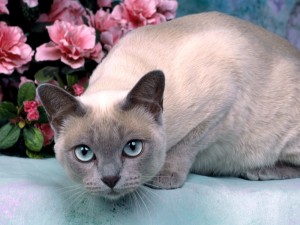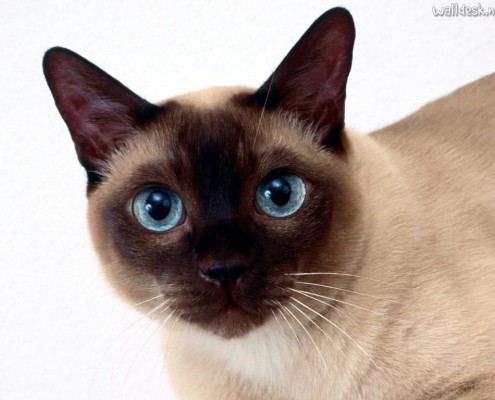Tonkinese

Meoww!!
The Tonkinese blends the best features of its ancestors into one beautiful, medium-sized cat that is remarkably dense and muscular.
In 5 Words
- Highly intelligent
- Curious
- Melodious voices
- Love attention
- Fondly
Snapshot
Size: Medium to Large
Weight: 6-12 lbs
Origin: Canada
Life Span: 10-15 years
Colour: Platinum, Champagne, Blue, Cream and Natural Mink

Characteristics
Learn About the Tonkinese
Tonkinese cats are the result of a recent crossbreeding between the Siamese and Burmese cat breeds, although some assert that Tonkinese-like cats have existed since at least the early 19th century, and the founding cat of the Burmese breed was probably a mink hybrid-colored cat named “Wong Mau,” a small walnut colored cat imported to California by Dr. Joseph Cheesman Thompson in 1930. In the 1960′s, a human named Margaret Conroy, who lived in Canada, finally wised up and decided to cross a Siamese and a Burmese. The resulting kittens were the original of what we know as the modern day Tonkinese. She soon realized what a prize had been created, and continued down the road to making history. A recent short-haired hybrid created by crossing Siamese and Burmese.
In its early days it was sometimes referred to as the Golden Siamese, and this name was used in print as recently as 1961. The Tonkinese cat has had an exotic, yet treacherous history. It originated from the Gulf of Tonkin, situated to the south of China and the east of North Vietnam. The Tonkinese is a Siamese-Burmese cross. Although it was first recognized by the Canadian Cat Association in 1971, Tonkinese cats have actually been around for quite some time. The first known depiction of a Tonkinese cat occurs in The Cat-Book Poems of Siam, written in Ayudha, Siam (now Thailand) sometime between 1358-1767.She worked tirelessly to spread the word about Tonkinese cats, and the breed was first given recognition by the Canadian Cat Association in 1974.
When the breed was first established in Canada, the breed name was actually spelled “Tonkanese,” which was a reference to the island in the musical South Pacific where “half-breeds” suffered no discrimination. The mistaken idea that the name was a geographical reference paralleling the Siamese and Burmese breed names resulted in a gradual switch to the current spelling, under which the breed was recognized by the United States registering associations. They were first accepted as a recognized cat breed by the Canadian Cat Association(CCA) and then by the Cat Fanciers Association(CFA) in 1984.
The Tonkinese blends the best features of its ancestors into one beautiful, medium-sized cat that is remarkably dense and muscular. Whether appearing in the coat pattern of its Burmese predecessor, with sparkling gold-green eyes, the pointed pattern of its Siamese ancestor, with glittering blue eyes, or the “mink” coat pattern seen in the show ring, with its unique aqua eyes, the Tonkinese is an intelligent, gregarious cat with a sense of humor. The breed comes in a variety of different colors and markings, including natural mink, champagne mink, blue mink, platinum mink, sable brown with points, champagne with points, blue with points, and platinum with points.
The Tonkinese looks similar to the Siamese. It comes in a variety of colors including dark brown, or seal; chocolate, which is a shade of brown; blue, which is actually a gray color; reddish brown; and a soft gray color referred to as lilac. The coat is short and fine yet silky and shiny. Tabby’s are now common among the Tonkinese breed. Tonkinese from other breeds of cat; it is clearly neither a self-coloured nor a pointed coat-pattern. There is a difference between the body colour and the darker points that is subtle rather than markedly contrasting where the points and body colour meet. The Tonkinese has no extreme physical features; it is a well-balanced cat of medium Foreign type.
Tonkinese Cats have a colorful personality to match its colorful coat. Tonks are ideal companions, highly intelligent and curious, they are fondly called, love attention and loathe solitude. For this reason, they would be more suited to a family rather than a single-owner household. They are people-cats and known for their tolerance of children. They are fun cats to watch and be around and they make excellent pets! They are sociable towards other cats and animals.The Tonkinese is a natural at inventing and playing games, using favorite toys to play fetch or delighting in games of tag and hide-and-seek with other pets – or even humans.
Tonkinese kittens are great fun, but even the adults tend to remain playful throughout their lives. Scratching/climbing posts and a variety of toys are much appreciated by these funloving cats. A Tonkinese will quickly take over, running your home and your life! They quickly endear themselves to family and visitors, becoming your “door greeter” and entertaining guests. These cats are also known to be stubborn and difficult to train. They are quite vocal, but the good news is that they have melodious voices. Tonkinese will hold a conversation with you and will always be interested in what you are doing. Tonkinese cats should be kept as indoor cats, they have a tendency to wander if allowed outside.
There are no serious genetic medical issues associated with the Tonkinese. However, these felines are susceptible to developing gingivitis, therefore a bit of preventive dental care may be required. The breed may share good longevity with its Siamese counterpart. brushing with a child’s toothbrush is useful. Care should also be taken by your vet when anesthesia is used. As kittens they sometimes get upper respritory infections (colds), but these are not usually serious.
May also develop some of the same diseases that affect the Siamese, including the following:
- Amyloidosis, a disease that occurs when a type of protein called amyloid is deposited in body organs, primarily the liver in members of the Siamese family
- Asthma/bronchial disease
- Congenital heart defects such as aortic stenosis
- Crossed eyes
- Gastrointestinal conditions such as megaesophagus
- Hyperesthesia syndrome, a neurological problem that can cause cats to excessively groom themselves, leading to hair loss, and to act frantically, especially when they are touched or petted
- Lymphoma
- Nystagmus, a neurological disorder that causes involuntary rapid eye movement
- Progressive retinal atrophy, for which a genetic test is available
Tonkinese are easy to care for cats. Bathing is optonal and not needed unless the cat gets really dirty. Routine nail trimming and occasional brushing is all the maintenance that is required. Some owners recommend a rubber curry brush, which the cats seem to enjoy. Fanciers recommend a good quality rubber cat brush with a concave surface to remove dead hair.






